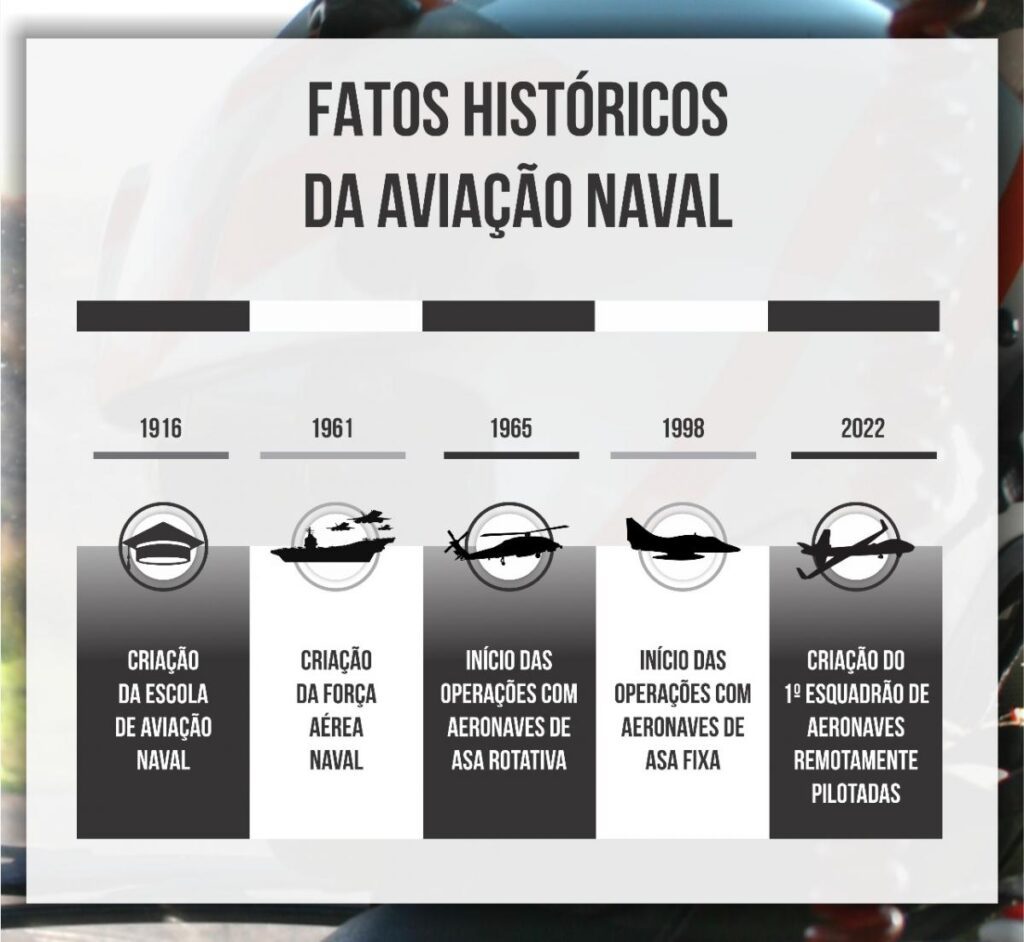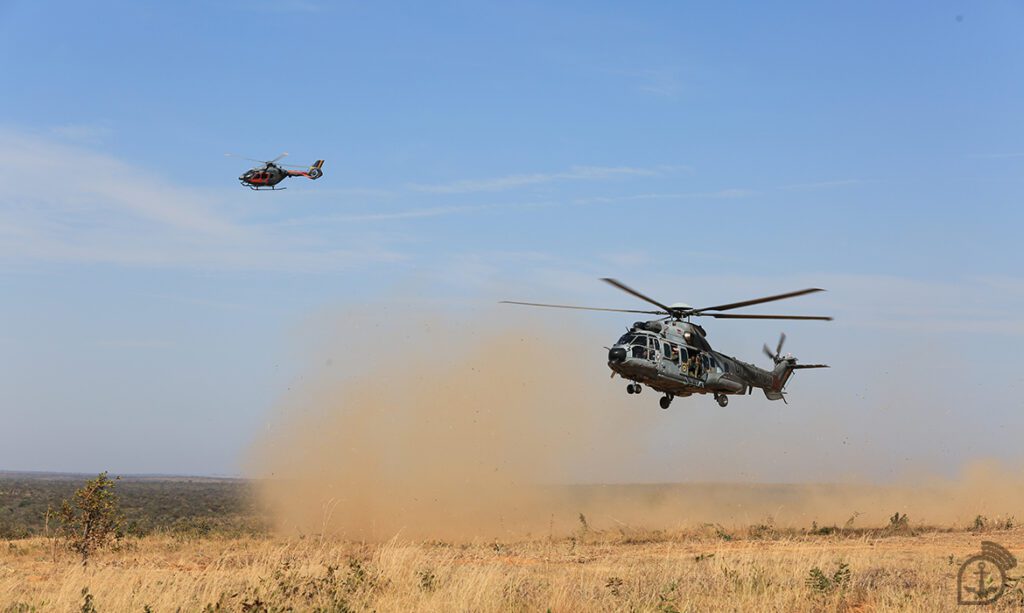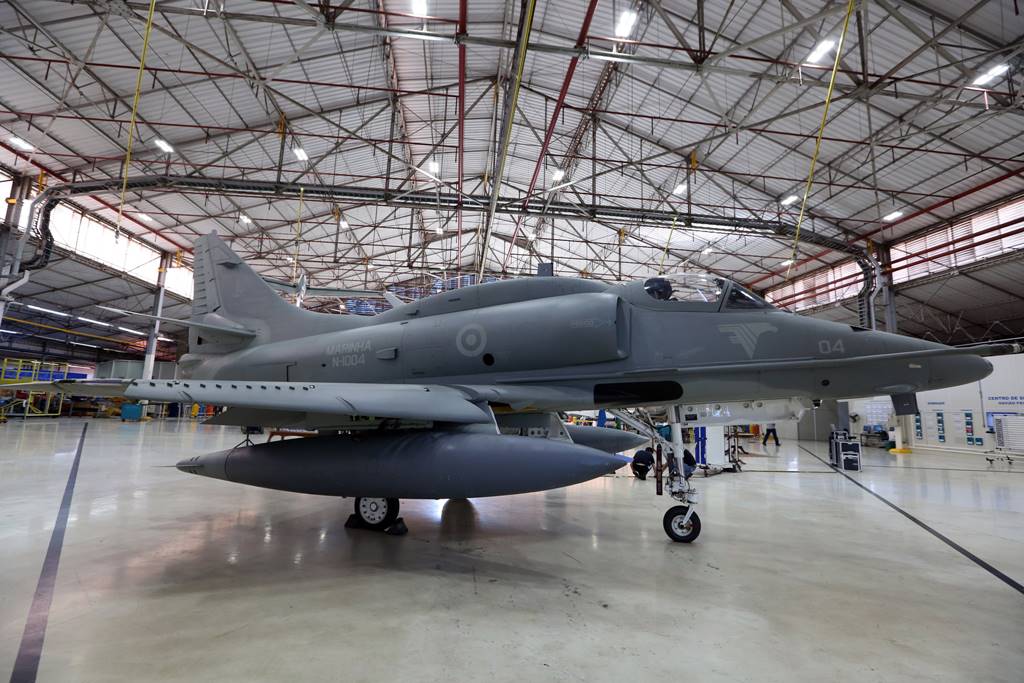Brazilian Naval Aviation completes 106 years with celebrations in São Pedro da Aldeia (RJ)
By Lieutenant-Captain (RM2-T) Luciano Franklin de Carvalho – São Pedro da Aldeia, RJ
The month of August in São Pedro da Aldeia, in the Lakes Region of Rio de Janeiro, is marked by various celebrations due to the anniversary of Naval Aviation, celebrated on the 23rd. The festivities include street races, exhibitions, and the traditional military parade held annually at the city’s Naval Air Base.
The city was chosen in the 1960s for the installation of the base, and is one of the 13 military organizations that currently make up the Naval Aviation Complex. Since then, it has maintained a historical-cultural relationship with the activity, and is known as the home of Naval Aviation. In 2020, at the entrance of São Pedro da Aldeia, at the edge of Praia do Centro, a military aircraft model AF-1 Skyhawk was installed, portraying the historical ties and welcoming symbol of the city.

This year, the military ceremony celebrating the anniversary of Naval Aviation was held this Friday (26). The event included flights over the main aircraft of the Brazilian Navy (MB). On the occasion, the Commander of the Navy, Admiral of Fleet Almir Garnier Santos, highlighted the achievements of 106 years of Naval Aviation.
“A pioneer in our country, the Aeronaval Force goes back to the year 1916, when the Navy introduced military aviation in Brazil. An initiative that proved to be visionary and that even today includes our Navy in the select list of those that operate embarked aviation,” praised the Navy Commander.
During the ceremony, the Commander of the Naval Air Force, Rear-Admiral Augusto José da Silva Fonseca Junior, said in his speech that the Air Force is expecting to receive two more AH-15B Super Cougar helicopters, which operate in search and rescue missions and support humanitarian actions, and is also expected to conclude the modernization program for the AH-11B Wild Lynx helicopters.

“The future, always challenging, pushes us to seek constant investments to provide our Air Force with the most modern and advanced aerial means and to improve the training of our air force personnel. As a result of this, the Naval High Administration has provided the renewal of the aircraft inventory, the modernization of the means and the courses, in the country and abroad, providing more and better operationality to the Force”, pointed out Admiral Fonseca Junior.
Since Santos Dumont made the first flight of the 14Bis, in 1906, aviation progressed in Brazil. This made possible the search for the construction of more aircraft and the training of personnel in the area, as well as a prospective vision of the potentialities of its use in the military field. Thus, the centennial history of Brazilian military aviation began to be built with the milestone on August 23, 1916, with the creation of the Naval Aviation School by the Navy.
The so-called first phase of Naval Aviation encompasses the period between 1916 and 1941, with a rapid development of aviation activities driven by the pioneering spirit of the MB. In addition to the creation of the Naval Aviation School, the period was marked by the transportation of the first civilian and military air mail, which promoted the later creation of the National Air Mail (CAN), as well as the first flight of a President of the Republic in a Brazilian military aircraft and the participation of naval aviators in real patrol operations, during World War I, as part of the 10th Operations Group of the Royal Air Force.

In January 1941, the Brazilian Air Force (FAB) was born, receiving all the aircraft, bases, equipment and personnel from both the Naval Aviation and the Army’s Military Aviation, ending the first phase. However, the Second World War proved the unequivocal necessity of having an onboard aviation to support ships at sea.
Because of this, in 1952, the Directorate of Navy Aviation was recreated, thus beginning the second phase of Naval Aviation, which lasted until 1961. This phase included a restructuring of the Armed Forces and was marked by the creation and installation of the Naval Aviation Training Center, in 1957, the arrival of the first helicopters, in 1958, and the arrival in Brazil of the light airship “Minas Gerais”, in 1961. That same year, the Naval Air Force Command was created and operations began in São Pedro da Aldeia.
Rotary Wing

In 1965, the Navy started to operate exclusively rotary wing aircrafts, giving its aircrafts to FAB and receiving from the latter advanced SH-34 anti-submarine helicopters. These facts marked the beginning of the third phase, a period in which there was a great development in the ability to use rotary-wing aircraft on board ships.
The MB was one of the few military forces in the world that operated with embarked helicopters, extending its operations into night periods and allowing the expansion of the operations capacity. Currently, one of the Navy’s helicopter highlights is the SH-16, designed to operate embarked and capable of performing a full anti-submarine warfare mission.
Fixed Wing

In 1998, the MB obtained authorization to operate fixed-wing aircraft again on board ships and acquired A-4 Skyhawk aircraft. Thus began the fourth phase of naval aviation, and Brazil joined the select group of countries with capacity to operate high performance aircraft from airplanes.
In April 2022, the modernization program for five AF-1B and two AF-1C fighters was concluded. Among the activities developed after this stage are the graduation flight with four AF-1 fighters conducted in July of this year by the 1st Interception and Attack Aircraft Squadron and the performance with attacks on targets in Operation Formosa 2022.
“Today in the VF-1 Squadron we have six pilots and all six were present in this flight of four aircraft. It was a very important flight and we were able to show the strength of the Squadron’s crew to put the aircraft in flight conditions. We performed an impeccable flight with different configurations and in any kind of formation. It was a flight that we hadn’t done for a few years and it helps a lot in training flights with close aircrafts”, said the pilot, Sea and War Captain José Assunção Chaves Neto.
New Times

In the year 2022, the Naval Aviation embarks on the fifth phase of its history, with the inauguration of the 1st Remotely Piloted Aircraft Squadron, which started the operations of a new type of aircraft in the Force with capacity to perform intelligence, surveillance and reconnaissance missions.
“The ScanEagle has excellent characteristics. The first is because it is very small, and it is difficult to see. It has a range capability around 100 km, which gives a great possibility of surveillance coverage. It doesn’t need a runway because it has a launcher and a collector, which is a factor of strength in use. We have the capacity to use it both from land and from sea. It has both electro-optical and infrared sensors and this gives us a 24-hour operation capability,” says the Squadron Commander, Frigate Captain Fábio Nunes.
The new phase is marked by the modernization and acquisition of aircraft and high-tech equipment providing technical and tactical combat innovations, such as the use of night vision goggles, technology that provides the ability to overcome the limitations of the human eye under conditions of low light and, consequently, low visibility.
Although Naval Aviation is concentrated in São Pedro da Aldeia, it operates throughout the country by means of four district squadrons, located in Belém (PA), Rio Grande (RS), Ladário (MS), and Manaus (AM). They make it possible to act in the Amazon, Pantanal, and Blue Amazon, protecting the country’s wealth and interests and abroad.
*** Translated by the DEFCONPress Team ***
